How Do You Field Dress a Black Bear
Issue #162 • November/December, 2016
Bear was a popular meat in our house when I was growing up in the rural woods. Black bear was Grandpa's favorite big game animal to hunt and Grandma praised it as being the most delectable of all game meats. Since Grandma had so many delicious recipes for delivering bear to the table, it was easy for her to back up her claim.
Nothing is more rewarding than having a stash of self-harvested, organic meat in the freezer and, like Grandma, I take a lot of pride in featuring it in gourmet fashion on the plate.
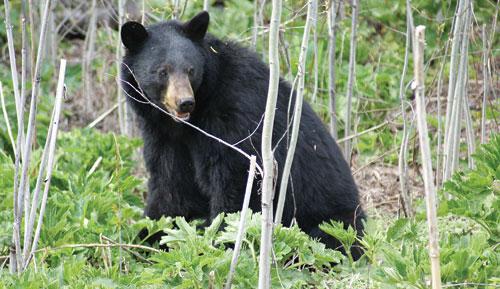
Hunting bear
Mature male bears average around 300 pounds and trophy bears can exceed 500 pounds. Mature bears, especially males, have large, full "block" heads, whereas the heads of immature bears are more pointed and narrow towards the nose. Female bears, called sows, are about half the size of males and typically are not far from their cubs (especially in spring), so observe carefully before placing a shot to ensure you are not aiming at a mother with her young.
Bears have fair eyesight, but their keen sense of smell and sharp hearing makes them a tricky game to stalk — which is my chosen mode for bear hunting. Some hunters prefer to "still" hunt using a tree stand. Either way, you need a lot of patience and skill to outsmart them, as they are an extremely intelligent animal.
Some zones offer bear hunting seasons in both spring and autumn while others may only have fall hunts. Before heading out on a bear expedition, be sure to study the hunting regulations carefully pertaining to the region of your planned hunt to ensure you are aware of all the rules, dates, and requirements — license, tags, firearm restrictions, and so forth.
Even though my hunting region offers both spring and fall hunts, I prefer to partake in the autumn hunt because I have more leisure time in the fall, whereas in spring my focus is usually on gardening and yard work. Another reason I fancy a fall bear is that I like to use bear lard for cooking and pastry making. The fat rendered off a fall bear that has fattened up for the winter on fruits and berries is much sweeter (and more plentiful) than that from a spring bear which has burned off its excess fat during hibernation. However, many bear meat connoisseurs vouch that a lean spring bear makes the finest eating, so either way you can't go wrong.
When hunting autumn bear, steer clear of those gorging on fish in the salmon-spawning rivers and creeks because their meat will have a fishy taste.
In order to have a successful autumn bear season, I find it helps to get out in the woodlands in summer and do some pre-season scouting. Autumn bears' favorite feeding areas are fields and meadows that are heavily hemmed in rosehips, blueberry flats, cranberry bogs, hazel and other nut-bearing woods, old orchards, and huckleberry, chokecherry, or any wild fruit stands. I look for all kinds of signs like tracks, scat, broken limbs on fruit trees, claw marks in bark, rotting logs that have been pawed and turned over by a grub-digging bear, and I make a mental note of areas around old growth and mature timber stands where a bear is most likely to den up for the winter. Once I locate prospective bear hunting grounds, I know I will have a good chance of setting my sights on a nice plump bruin when the season opens.
For spring bear, I find the best places to hunt are around the sunny open brims of mature forests where the bear may have denned up for the winter and is now out looking for greenery on which to feast and re-fatten up. Grassy meadowlands and moist woodlands where skunk cabbage, fiddleheads, nettles, and dandelions flourish are good spots to look for bears feeding.
Field dressing
The first thing you should consider after shooting a bear is whether or not you are going to have the head mounted (a decision some hunters make instantly upon bagging a trophy animal) or have the hide tanned or made into a rug. If you plan on preserving it, you will want to take extra care during the field dressing and skinning process in order to avoid making unnecessary nicks in the hide and, of course, to leave the head, tail, and paws intact for mounting purposes.
The biggest secret to good meat is to field dress the animal as quickly as possible after shooting it. Nothing taints meat quicker than the retention of body heat. Some hunters simply skin out the animal and remove the four legs, leaving the remainder behind in the field — sometimes with the stomach unopened and the guts intact should the organ meats and ribs not be on the menu.
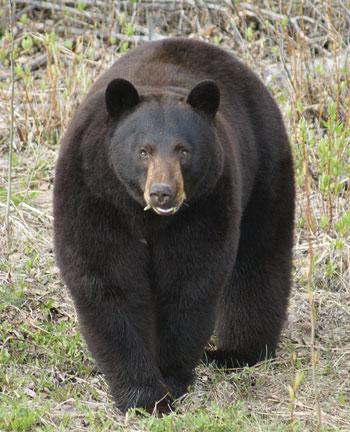
Field dress a bear in the same manner as you would any other big game animal. Make the initial circle slit around the vent and then go up the middle of the belly to the chest, being careful not to puncture the stomach or intestines, as spillage can taint the meat. Then roll the animal on its side and empty the guts out of the cavity. To free the heart and lungs, cut the diaphragm in the chest close to the ribs. Sop out as much excess blood from the cavity as possible using paper towels carried in your pack, or ferns and other greenery if nothing else is available.
The next step is to skin it out. Since bears have very thick fur, the sooner you get the hide off the better, in order for the cooling-down process to begin. Lay the bear on its back and extend the initial incision made while field dressing down the entire length of each leg. If you're preserving the hide, make these cuts as straight and neat as possible right down to the pads of the feet, leaving them intact. You can skin down to the ankle and disjoint the feet to remove them if you're not concerned with the hide.
Once you make these additional cuts, begin skinning. Using your knife, free the hide from the body as you go. If the hide's destination is a taxidermist, it should be delivered as quickly as possible, especially if the weather is warmer. The hide can be salted down and rolled up into a ball to help prevent spoilage.
Processing
If you are processing a spring bear when the weather is warmer and the bear has much less fat, the meat should be butchered and chilled as quickly as possible. But when it comes to an autumn bear harvested during cooler weather, I like to hang it for a day or two in order for the meat to bleed out and stiffen up and for the fat to harden a little (which makes for easier butchering). I butcher my own meat so this is what works best for me. However, if you have your meat professionally processed, it will be done according to the shop's standards and your own requests.
The first step is to remove the fat layer from the meat. A plump autumn bear can have up to three inches of fat on it, so have a big tub handy to throw the fat into if saving it to render down into lard (for cooking or for leather preservation and lubrication). If not, then you can hang it in the backyard trees for the birds or discard it — but that's a lot of waste! Removing the fat from a bear is much the same as doing so from a pig — simply slice it off in strips until you have worked your way down to the meat layer.
Even though the fat is very tasty when rendered down into lard it can impart an "off" taste if left on the meat, especially after a stint in the freezer. When grinding bear into burger, I trim off all the excess fat and replace it with pork fat for grinding with the lean meat. This gives the meat binding power, a better taste, and makes the meat more suitable for long-term storage.
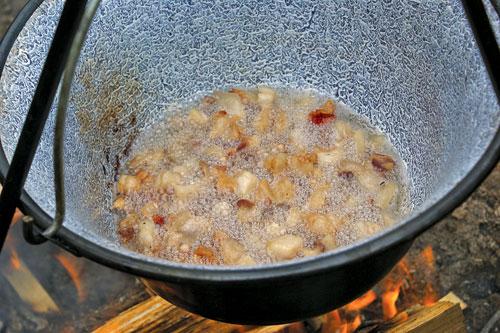
Rendering down bear lard
There are two methods to render bear lard: one melts the fat down without the use of water and the other uses water. I like to render my bear lard in a pot hanging over the backyard fire pit, but it can be done on the stove indoors. Work in small batches and don't crowd the pan, or the grease may bubble over. Keep kids and pets away from the melting pot!
Without water: Cut the fat into small cubes and put into a large, deep, heavy-bottomed pot. Hang the pot over the fire or turn the stove burner to medium-high. The fat will begin to melt down and as the bottom of the kettle fills with grease the fat will fry itself out. When the hard bits of fat turn into a bunch of floating crispy little pieces, the lard is done. Ladle the "cracklings" into a metal sieve, hold over the pot of rendered grease, and press any remaining fat out of the cracklings with the back of a wooden spoon. Empty cracklings onto absorbent paper, sprinkle with salt, and eat while you wait for the lard to cool. When lard is cool, transfer it to an earthen container, cover, and store in fridge or a cool place.
With water: Cut fat as above and put into a large kettle. Cover with cold water. Bring to a boil. Simmer over low heat for 4 to 5 hours, skimming off impurities as they rise to the top. Since this method takes so long it is ideal for use with a woodstove that is always burning in the corner of the kitchen. Continue simmering until the water has evaporated and the fat is rendered. Be careful not to burn the fat when it boils down to the frying point.
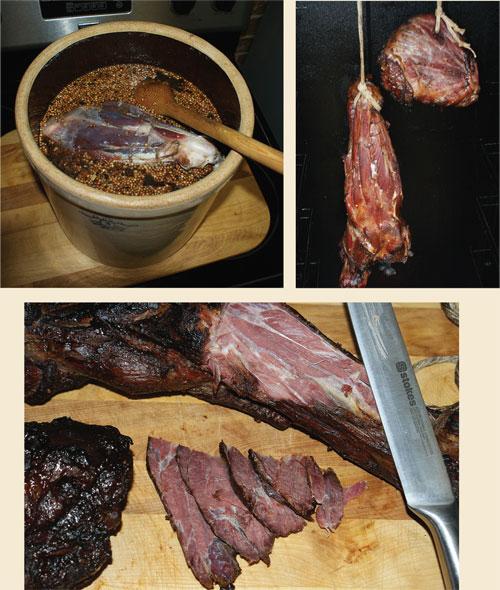
Butchering
Butchering a bear is pretty much the same as butchering a hog. I like to set one leg aside for making ham and just bone out the rest, which is easier than sawing through bones. I butcher the meat into steaks, roasts, stewing meat, and trims for burger. The meat from the neck and ribs (if not saving for BBQ) are ideal for grinding. The heart is delicious roasted in the same fashion as a venison heart. Some folks like the liver, too. I find it a little stronger tasting than venison liver, but soaking it in milk before cooking gives it a milder flavor.
Packaging the meat
I used to use freezer paper, but no matter how I wrapped it, after a few months in the freezer, the meat would get freezer burn. A number of years ago, I bought a vacuum sealer and since then, I have never had a package of meat get frostbite — even ones that have outlived their prime shelf life of one year in the freezer. I do wrap my vacuum-sealed meat in a jacket of brown freezer paper which prevents the color from fading, especially during long-term storage.
Ground meat and stewing meat can be sealed in ziplock bags, but larger cuts where the air can circulate around really do survive longer when vacuum-sealed.
Recipes
Cured smoked bear ham
This recipe makes a delicious ham — whether you use the traditional top prime "ham" portion of the leg or the lower leg. I prefer to make hams from meat that has been frozen for at least six months — not only as an extra precaution to safeguard against trichinosis but also because the ham seems to turn out better than that made from fresh meat.
10-15 lbs. bone-in bear leg (ham)
1½ gallons cold water (more if needed)
1 cup plus 2 Tbsp. of commercial meat cure (Morton Tender Quick — follow their measurements if different)
2½ cups brown sugar
¼ cup pickling spices (or a mix of whole coriander, black and white mustard seeds, black peppercorns, and crushed bay leaves)
1 Tbsp. black peppercorns (optional but I like it a bit more "peppery")
1 Tbsp. crushed dried chile peppers (optional)
3 Tbsp. dehydrated garlic
Thaw the meat. If you didn't trim the excess fat from the leg upon freezing, trim it well. Put the ham into an earthen crock or food-grade vessel that is large enough to submerge the ham. Mix remaining ingredients together until fully dissolved. Using a syringe or meat injector, pump the brine into the ham at various locations or poke holes into the meat with a skewer so the brine will work into the meat. Put the ham into the container and cover it with the brine, adding more water if necessary in order to have it completely submerged. Use a clean rock placed on top of the ham to keep the ham submerged. Cover with cloth. Set in a cool place and brine for 10 days.
After 10 days, remove the ham from the brine and rinse under cold running water. Set on a rack and allow to air dry until tacky. Run a meat string through the "ankle-end" of the meat for hanging the ham. You can leave the ham in one large piece or cut into two pieces, which works better for smaller smokers.
Preheat smoker to 120° F. Hang the ham in the smoker and hold at this temperature (without smoke) for two hours.
Add wood chips (I like to use wood chips from fruit trees like cherry or apple). Raise smoker temperature to 180° F. Smoke until the internal temperature at the bone has reached 155° F. In my smoker, this can take 8-10 hours. I like it very well done, even to the point of being a little crispy at the edges, but you can adjust to suit your own tastes. For safety's sake, do not underestimate the time needed to reach a proper degree of doneness.
Cool the ham completely and store as you would store any large cured, smoked ham. The ham is ready to eat or it can be cooked as you would any cured smoked ham. I wrap mine in cheesecloth and hang the ham in my larder if the weather is cool. But if the weather is not agreeable, I store it in the fridge for up to a couple weeks (by which time it is usually eaten), but if longer storage is needed I find cutting it into usable portions, vacuum-sealing, and then freezing works great.
Bear ribs with blueberry and juniper BBQ sauce
I like to soak bear ribs in a wine and garlic marinade, then boil them until they are tender. Then I place them on the grill and cook, basting constantly, until well glazed.
This fragrant, sweet and tangy sauce is a perfect match for bear ribs.
3 Tbsp. olive oil
1 onion, chopped
5 garlic cloves, minced
1 jalapeño pepper, diced
1 cup ketchup
¼ cup honey
¼ cup brown sugar
¼ cup blueberries
2 juniper berries, crushed (use a mortar and pestle)
1 tsp. ground coriander
½ tsp. ground cumin
½ tsp. salt
1 tsp. black pepper
2 Tbsp. apple cider vinegar
1 Tbsp. Worcestershire sauce
Heat olive oil in a saucepan, then add onion, garlic, and jalapeño pepper until soft. Add ketchup, honey, brown sugar, blueberries, juniper berries, and spices. Stir in apple cider vinegar and Worcestershire sauce. Cook until berries burst and sauce is thick. Taste and adjust sweetness by adding more honey or sugar, or tartness by stirring in more vinegar. Leftover sauce can be stored in a capped jar in the fridge for several weeks.
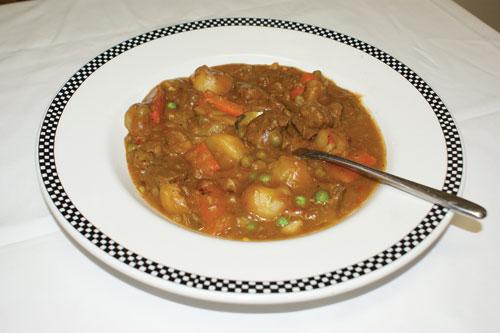
Grandma's old-fashioned bear stew
You can't beat a hearty bear stew loaded with herbs, colorful root vegetables, and tender meat in rich gravy. Goes great with a wedge of biscuit made from bear lard or crusty bread for sopping up the gravy. Serves six.
1½ pounds stewing bear
2 Tbsp. cooking fat (lard, butter, or vegetable oil)
1 large onion, chopped
4 cloves garlic, minced
¼ cup celery, diced
1 sweet red pepper, diced
1½ Tbsp. paprika
1 tsp. ground black pepper
1½ tsp. salt (or to suit taste)
couple sprigs of fresh herbs of choice — rosemary, oregano, basil, thyme
3½ cups (or more) water
2 cups potatoes, peeled and cubed (or whole baby)
1 cup diced turnip
1 parsnip, chopped
2 cups chopped carrots
1 cup frozen peas
½ cup red wine (or water)
2 Tbsp. flour blended into ¼ cup water (or omit salt and use instant beef gravy mix)
Heat fat in Dutch oven. Sauté meat until it loses its color. Add onions, garlic, celery, and pepper and cook until onion is soft. Stir in the spices and cook until absorbed. Add water, bring to a boil, reduce heat, cover, and simmer for 1½ hours or until meat is tender, adding more water as needed. Add vegetables and wine. Simmer 30 minutes or until vegetables are cooked. Stir in flour/water mixture and cook until thickened. Taste and adjust seasonings.
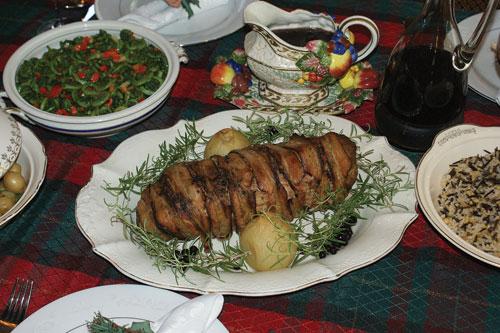
Peppered bacon-wrapped bear roast
I use a prime boneless piece of meat for this recipe. For a totally wild supper, serve this roast with steamed fiddleheads dressed with red peppers and a drizzle of butter. Serves eight.
3-4 lb. boneless bear roast, trimmed of all fat
4 to 5 cloves sliced garlic
1 Tbsp. black peppercorns
1 Tbsp. whole coriander seeds
6 (more or less) slices of smoked bacon
3 cups water
2 large onions
Thaw meat completely. Make one- inch slashes into the meat on all sides and insert the garlic slices. Slightly crush the peppercorns and coriander seeds using a mortar and pestle. Mix them together and rub them into the meat on all sides. Wrap bacon slices around the meat to cover, using as many slices as needed, tucking ends underneath the meat. Place roast on a rack in roasting pan. Add water to the bottom of the pan and set in onions. The meat will draw a nice onion flavor through the steam during cooking. Cover the pan tightly with a lid or heavy foil. Roast in preheated 450° F oven for 30 minutes. Add more water, if needed. Reduce heat to 350° F and continue roasting until meat thermometer registers 185° F in center of the meat. Remove foil and roast uncovered for 15 to 20 minutes or until bacon is golden. Transfer to platter, drape loosely with foil, and let stand 10 minutes to ensure even slicing. Onions can be used to decorate the platter and fresh sprigs of rosemary can be placed around the meat for extra flair.
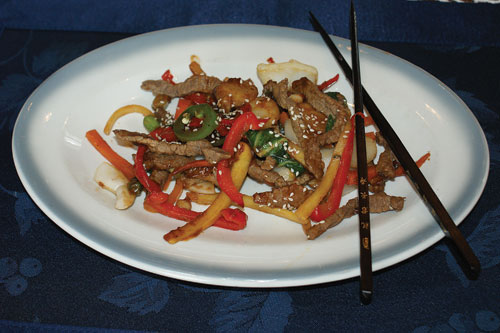
Gingered bear strips
My family loves this dish with steamed rice or Asian-style noodles. Serve with chopsticks for fun and authentic flair. Serves four to six.
Marinade:
1½ lbs. bear steak, cut into very thin strips
¼ cup red wine
2 Tbsp. soy sauce
3 cloves minced garlic
1 tsp. black pepper
2 Tbsp. grated ginger root
Stir fry:
3 Tbsp. vegetable oil
1 onion, sliced
2 carrots, cut into matchsticks
1 red sweet pepper, cut into matchsticks
1 green sweet pepper, cut into matchsticks
1 chile pepper, cut into thin rings
1 cup whole snow peas
3 Tbsp. liquid honey
¼ cup sweet chili or plum sauce
2 Tbsp. soy sauce
1 Tbsp. sesame oil
1 Tbsp. cornstarch mixed into 2 Tbsp. water
3 chopped green onions
sesame seeds
Put bear strips into ziplock bag along with wine, soy sauce, garlic, black pepper, and ginger root; mix well. Marinate in fridge for several hours (the longer, the more gingery the flavor will be). Drain meat, reserving marinade. Heat oil in wok. Stir-fry meat in oil until it is cooked. Add vegetables, stir-fry until merely tender. Add honey, chili and soy sauces, sesame oil, and reserved marinade to the wok; cook 5 minutes. Pour in cornstarch and water mixture, cook until thickened and clear. Garnish with green onions and sesame seeds.
Buttermilk bear-lard biscuits
Fresh bear cracklings (the bits of crispy golden pieces left over after rendering down the lard) can be crushed and added to the biscuit dough for an exceptionally tasty biscuit. Makes 12 to 15 biscuits, depending on size. For variety, add grated cheese or dried herbs to the dough. When I'm in a hurry, I often just bake the dough in one big round, then cut into wedges for serving.
2 cups all purpose flour
2 tsp. baking powder
½ tsp. baking soda
½ tsp. salt
¼ cup bear lard (or pork lard or shortening)
1 cup buttermilk
Mix dry ingredients in bowl. Cut in lard until mixture resembles coarse cornmeal. Make a well and stir in the buttermilk, mixing until blended. Turn out on floured surface and knead lightly. Roll into a circle ½-inch thick and cut into desired-sized biscuits. Put on ungreased baking sheet and bake in preheated 450° F oven for 15 to 20 minutes or until puffed and golden.
Bear steaks with fresh spring morels
This is a spring bear hunter's special. If you don't have any luck hunting down morels, then store-bought mushrooms can be used. One of the best places to search for morels is in the leaf rot of deciduous trees. When morels are plentiful, I dry them for future use, allowing me to make this recipe with steaks from an autumn bear, too. Serves four.
4 bear steaks
4 cloves sliced garlic
4 sprigs rosemary
1 tsp. black peppercorns
1 Tbsp. olive oil
½ cup sherry
3 Tbsp. butter
1 cup beef stock or water
2 peeled sliced shallots
1 cup fresh morels (or dried morels, rehydrated)
¼ cup heavy cream
salt and pepper to taste
Put steaks into a flat dish, scatter tops with garlic, rosemary, and peppercorns. Mix olive oil and sherry, pour over top of meat. Marinate in fridge for several hours or overnight. Remove steaks from marinade, reserve. Heat butter in skillet, sauté steaks until golden on each side. Pour in the stock and reserved marinade. Cover and simmer until meat is thoroughly cooked and liquid is absorbed. Remove meat from pan and hold hot. Add shallots and morels to the drippings and cook until shallots are soft. Stir in the cream and seasonings. Cook until thick. Ladle mushrooms over the steaks, garnish with fresh parsley. Goes great with mashed potatoes and peas.
Bear steaks with crusty blue cheese topping
I've had friends who shunned bear meat until they tried this steak. Serve with sautéed mushrooms and red wine for toasting your good fortune. The recipe below is geared for two but can be multiplied to feed as many as needed.
2 (6-8 oz.) boneless bear steaks
2 cloves sliced garlic
sprinkle of black pepper
¼ cup red cooking wine
1 Tbsp. olive oil
3 Tbsp. soft butter, divided
1 cup water
1 Tbsp. prepared horseradish
¼ cup crumbled blue cheese
½ cup Italian seasoned bread crumbs (homemade or store-bought)
2 Tbsp. minced chives or green onions
Put steaks into a dish and place garlic on top. Sprinkle with pepper and pour wine over top. Cover and refrigerate for several hours, turning several times. Remove meat and pat dry with paper towels, reserving marinade.
Heat oil and 1 Tbsp. butter in cast-iron or heavy skillet and fry meat until it is browned on one side. Flip and cook until the underside is also browned. Reduce heat, pour in the reserved marinade and water, then cover and cook until liquid is evaporated and meat cooked thoroughly.
Do not undercook your bear steaks. They must be medium to well-done for safe eating.
When done, remove steaks from pan and place on a baking sheet. Preheat oven broiler to 450° F. Mix the remaining butter, horseradish, and blue cheese together in a bowl until well blended. Work in the bread crumbs and chives.
Spread the mixture over top of the steaks and cook under broiler until the crust turns golden, about 3 to 4 minutes.
Spicy bear breakfast sausage
This recipe is perfect for beginning sausage makers because the sausages are not cased, which means they are formed into sausage "loaves" ready for slicing into patties. Makes about 3 pounds.
2 lbs. ground bear meat
1 lb. ground fatty pork (I like to use a piece of pork butt)
1 tsp. salt
1 tsp. black pepper
1 tsp. ground marjoram
½ tsp. crushed sage
1 tsp. garlic powder
2 tsp. onion powder
1 tsp. sweet red paprika
2 tsp. whole coriander seeds
1 tsp. crushed dried chile flakes
Mix the ground meats together in a large bowl, then add spices. Using your hands, work the spices into the meats.
Shape the meat into two rolls. I like to make them about the same size of an English muffin, which makes them an ideal size for a breakfast egg and sausage muffin. Cover, set in the fridge, and leave overnight.
The next morning, slice the rolls into patties, then fry in hot oil over medium heat until browned on both sides and cooked through. Drain on absorbent paper before serving.
Glazed bear meatloaf
This is always a family favorite and it is as good cold as it is hot.
1½ lbs. ground lean bear meat
1 lb. regular ground pork (not lean ground)
1 minced onion
4 cloves minced garlic
1 tsp. salt
1½ tsp. black pepper
½ tsp. ground marjoram
1½ cups crushed soda cracker crumbs (or dried bread crumbs)
2 eggs
1 Tbsp. Worcestershire sauce
Mix all ingredients into a large bowl. Pack into a greased medium to large loaf pan, or two smaller pans, if you'd rather. Cover loaf pan tightly with foil. Set in a large roasting pan and half fill with water. Put on lid and bake in 350° F oven for 2 hours. Remove. Take loaf pan out of roaster and remove foil. Cover with glaze. Return to the oven and bake uncovered for 30 minutes or until meat is cooked through and top of loaf is glossy. For even slicing, let stand 10 minutes before serving.
Glaze: Mix together 4 Tbsp. ketchup, 1 Tbsp. stone-ground mustard, and 1½ Tbsp. liquid honey.
A word about trichinosis
Treat bear with the same precaution as pork to safeguard against trichinosis — a disease caused by the presence of parasites which can live in the intestines of a variety of animals. It is most commonly found in pork in the domestic world and bear in the field. Since trichinae larvae cannot be seen with the naked eye, there is no way to detect its absence or presence — thus safe handling is the key to safe eating.
Trichinosis can be transmitted to humans by eating the undercooked flesh of infected animals. Most human cases are related to the eating of undercooked pork. Since bear, like pork, may be carrying the parasites in the meat, it must be handled like pork and cooked to a proper degree of doneness.
Bear should be cooked until the internal temperature reaches 185° F on a meat thermometer in the center of the meat. It should be fork tender and there should be no bloody juices present. Since freezing is also known to help kill trichinae, a nice long stint in the freezer before using is good practice — especially for ham and sausage making.
How Do You Field Dress a Black Bear
Source: https://www.backwoodshome.com/hunting-processing-and-serving-black-bear/
0 Response to "How Do You Field Dress a Black Bear"
Post a Comment